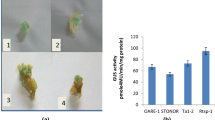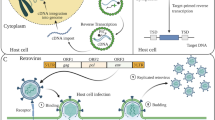Abstract
Retrotransposons are a major component of eukaryote genomes, being especially abundant in plant genomes. They are frequently found inserted in gene-rich regions and have greatly contributed to the evolution of gene coding capacity and regulation. Retrotransposon insertions can influence the expression of neighboring genes in many ways, such as modifying their promoter or terminator sequences and altering their epigenetic control. Plant retrotransposons are highly regulated and their expression is usually associated with stress situations. While the control of transcription of some plant retrotransposons has been analyzed in some detail, little is known about the transcriptional termination of these elements. Here we show that the transcripts of the tobacco retrotransposon Tnt1 display a high variability of polyadenylation sites, only a fraction of them terminating at the major termination site. We also report on the ability of Tnt1 to extend its transcription into flanking genomic sequences and we analyze a particular case in which Tnt1 transcripts include sequences of an oppositely oriented resistance-like gene. The expression of this gene and the neighboring Tnt1 copy generate transcripts overlapping in more that 800 nucleotides, which could anneal and form dsRNAs and enter into silencing regulatory pathways. Resistance gene loci are usually composed of tandem arrays of resistance-like genes, a number of which contain mutations, including retrotransposon insertions, and are considered as to be pseudogenes. Given that plant retrotransposons are usually regulated by stress, the convergent expression of these resistance-like pseudogenes and the interleaving inducible retrotransposons may contribute to the control of plant responses to stress.





Similar content being viewed by others
References
Ballvora A, Jocker A, Viehover P, Ishihara H, Paal J, Meksem K, Bruggmann R, Schoof H, Weisshaar B, Gebhardt C (2007) Comparative sequence analysis of Solanum and Arabidopsis in a hot spot for pathogen resistance on potato chromosome V reveals a patchwork of conserved and rapidly evolving genome segments. BMC Genomics 8:112
Beguiristain T, Grandbastien M-A, Puigdomenech P, Casacuberta JM (2001) Three Tnt1 subfamilies show different stress-associated patterns of expression in tobacco. Consequences for retrotransposon control and evolution in plants. Plant Physiol 127:212–221
Belkhadir Y, Subramaniam R, Dangl JL (2004) Plant disease resistance protein signaling: NBS-LRR proteins and their partners. Curr Opin Plant Biol 7:391–399
Casacuberta JM, Grandbastien M-A (1993) Characterisation of LTR sequences involved in the protoplast specific expression of the tobacco Tnt1 retrotransposon. Nucleic Acids Res 21:2087–2093
Casacuberta JM, Vernhettes S, Grandbastien MA (1995) Sequence variability within the tobacco retrotransposon Tnt1 population. EMBO J 14:2670–2678
Casacuberta J, Vernhettes S, Audeon C, Grandbastien M-A (1997) Quasispecies in retrotransposons: a role for sequence variability in Tnt1 evolution. Genetica 100:109–117
Chang W, Schulman AH (2008) BARE retrotransposons produce multiple groups of rarely polyadenylated transcripts from two differentially regulated promoters. Plant J 56(1):40–50
Deragon J, Casacuberta JM, Panaud O (2008) Plant Transposable Elements. In: Volff JN (ed) Genome dynamics. Basel, Karger, pp 69–82
Friedman AR, Baker BJ (2007) The evolution of resistance genes in multi-protein plant resistance systems. Curr Opin Genet Dev 17:493–499
Furger A, Monks J, Proudfoot NJ (2001) The retroviruses human immunodeficiency virus type 1 and Moloney murine leukemia virus adopt radically different strategies to regulate promoter-proximal polyadenylation. J Virol 75:11735–11746
Graham MA, Marek LF, Shoemaker RC (2002) Organization, expression and evolution of a disease resistance gene cluster in soybean. Genetics 162:1961–1977
Grandbastien MA, Audeon C, Bonnivard E, Casacuberta JM, Chalhoub B, Costa APP, Le QH, Melayah D, Petit M, Poncet C, Tam SM, van Sluys MA, Mhiri C (2005) Stress activation and genomic impact of Tnt1 retrotransposons in Solanaceae. Cytogenet Genome Res 110:229–241
Huang S, van der Vossen E, Kuang H, Vleeshouwers V, Zhang N, Borm T, van Eck H, Baker B, Jacobsen E, Visser R (2005) Comparative genomics enabled the isolation of the R3a late blight resistance gene in potato. Plant J 42:251–261
Ji G, Zheng J, Shen Y, Wu X, Jiang R, Lin Y, Loke J, Davis K, Reese G, Li Q (2007) Predictive modeling of plant messenger RNA polyadenylation sites. BMC Bioinformatics 8:43
Johansen LK, Carrington JC (2001) Silencing on the spot Induction and suppression of RNA silencing in the agrobacterium-mediated transient expression system. Plant Physiol 126:930–938
Jordan IK, Rogozin IB, Glazko GV, Koonin EV (2003) Origin of a substantial fraction of human regulatory sequences from transposable elements. Trends Genet 19:68–72
Kashkush K, Khasdan V (2007) Large-scale survey of cytosine methylation of retrotransposons and the impact of readout transcription from long terminal repeats on expression of adjacent rice genes. Genetics 177:1975–1985
Kashkush K, Feldman M, Levy A (2002) Transcriptional activation of retrotransposons alters the expression of adjacent genes in wheat. Nat Genet 33:102–106
Kashkush K, Feldman M, Levy AA (2003) Transcriptional activation of retrotransposons alters the expression of adjacent genes in wheat. Nat Genet 33:102–106
Kinoshita Y, Saze H, Kinoshita T, Miura A, Soppe W, Koornneef M, Kakutani T (2007) Control of FWA gene silencing in Arabidopsis thaliana by SINE-related direct repeats. Plant J 49:38–45
Kuang H, Wei F, Marano M, Wirtz U, Wang X, Liu J, Shum W, Zaborsky J, Tallon L, Rensink W, Lobst S, Zhang P, Tornqvist C, Tek A, Bamberg J, Helgeson J, Fry W, You F, Luo MC, Jiang J, Robin Buell C, Baker B (2005) The R1 resistance gene cluster contains three groups of independently evolving, type I R1 homologues and shows substantial structural variation among haplotypes of Solanum demissum. Plant J 44:37–51
Le Q, Melayah D, Bonnivard E, Petit M, Grandbastien M (2007) Distribution dynamics of the Tnt1 retrotransposon in tobacco. Mol Genet Genomics 278:1617–4615
Li Q, Hunt AG (1997) The polyadenylation of RNA in plants. Plant Physiol 115:321–325
Logemann J, Schell J, Willmitzer L (1987) Improved method for the isolation of RNA from plant tissues. Anal Biochem 163:16–20
Loke JC, Stahlberg EA, Strenski DG, Haas BJ, Wood PC, Li QQ (2005) Compilation of mRNA polyadenylation signals in Arabidopsis revealed a new signal element and potential secondary structures. Plant Physiol 138:1457–1468
Lunyak VV, Prefontaine GG, Nunez E, Cramer T, Ju B-G, Ohgi KA, Hutt K, Roy R, Garcia-Diaz A, Zhu X, Yung Y, Montoliu L, Glass CK, Rosenfeld MG (2007) Developmentally regulated activation of a SINE B2 repeat as a domain boundary in organogenesis. Science 317:248–251
Maciolek NL, McNally MT (2008) Characterization of Rous sarcoma virus polyadenylation site use in vitro. Virology 374:468–476
Medstrand P, van de Lagemaatb L, Dunnb C, Landryb J-R, Svenbacka D, Mager D (2005) Impact of transposable elements on the evolution of mammalian gene regulation. Cytogenet Genome Res 110:342–352
Miyao A, Tanaka K, Murata K, Sawaki H, Takeda S, Abe K, Shinozuka Y, Onosato K, Hirochika H (2003) Target site specificity of the Tos17 retrotransposon shows a preference for insertion within genes and against insertion in retrotransposon-rich regions of the genome. Plant Cell 15:1771–1780
Noel L, Moores TL, van der Biezen EA, Parniske M, Daniels MJ, Parker JE, Jones JDG (1999) Pronounced intraspecific haplotype divergence at the RPP5 complex disease resistance locus of Arabidopsis. Plant Cell 11:2099–2112
Paal J, Henselewski H, Muth J, Meksem K, Menéndez C, Salamini F, Ballvora A, Gebhardt C (2004) Molecular cloning of the potato Gro1–4 gene conferring resistance to pathotype Ro1 of the root cyst nematode Globodera rostochiensis, based on a candidate gene approach. Plant J 38:285–297
Proudfoot N (2004) New perspectives on connecting messenger RNA 3′ end formation to transcription. Curr Opin Cell Biol 16:272–278
Ramakrishna W, Emberton J, Ogden M, SanMiguel P, Bennetzen JL (2002) Structural analysis of the maize Rp1 complex reveals numerous sites and unexpected mechanisms of local rearrangement. Plant Cell 14:3213–3223
Saitou N, Nei M (1987) The neighbor-joining method: a new method for reconstructing phylogenetic trees. Mol Biol Evol 4:406–425
Shen Y, Ji G, Haas BJ, Wu X, Zheng J, Reese GJ, Li QQ (2008) Genome level analysis of rice mRNA 3′-end processing signals and alternative polyadenylation. Nucleic Acids Res 36(9):3150–3161
Simons G, Groenendijk J, Wijbrandi J, Reijans M, Groenen J, Diergaarde P, Van der Lee T, Bleeker M, Onstenk J, de Both M, Haring M, Mes J, Cornelissen B, Zabeau M, Vos P (1998) Dissection of the fusarium I2 gene cluster in tomato reveals six homologs and one active gene copy. Plant Cell 10:1055–1068
Tam OH, Aravin AA, Stein P, Girard A, Murchison EP, Cheloufi S, Hodges E, Anger M, Sachidanandam R, Schultz RM, Hannon GJ (2008) Pseudogene-derived small interfering RNAs regulate gene expression in mouse oocytes. Nature 453:534–538
Thompson JD, Gibson TJ, Plewniak F, Jeanmougin F, Higgins DG (1997) The CLUSTAL_X windows interface: flexible strategies for multiple sequence alignment aided by quality analysis tools. Nucleic Acids Res 25:4876–4882
van de Lagemaat LN, Landry J-R, Mager DL, Medstrand P (2003) Transposable elements in mammals promote regulatory variation and diversification of genes with specialized functions. Trends Genet 19:530–536
van Leeuwen H, Monfort A, Zhang H-B, Puigdomènech P (2003) Identification and characterisation of a melon genomic region containing a resistance gene cluster from a constructed BAC library. Plant Mol Biol 51:703–718
Vernhettes S, Grandbastien M-A, Casacuberta JM (1997) In vivo characterization of transcriptional regulatory sequences involved in the defence-associated expression of the tobacco retrotransposon Tnt1. Plant Mol Biol 35:673–679
Vernhettes S, Grandbastien MA, Casacuberta JM (1998) The evolutionary analysis of the Tnt1 retrotransposon in Nicotiana species reveals the high variability of its regulatory sequences. Mol Biol Evol 15:827–836
Vitte C, Bennetzen JL (2006) Eukaryotic transposable elements and genome evolution special feature: analysis of retrotransposon structural diversity uncovers properties and propensities in angiosperm genome evolution. Proc Natl Acad Sci 103:17638–17643
Wang G-L, Ruan D-L, Song W-Y, Sideris S, Chen L, Pi L-Y, Zhang S, Zhang Z, Fauquet C, Gaut BS, Whalen MC, Ronald PC (1998) Xa21D encodes a receptor-like molecule with a leucine-rich repeat domain that determines race-specific recognition and is subject to adaptive evolution. Plant Cell 10:765–780
Wei F, Wing RA, Wise RP (2002) Genome dynamics and evolution of the Mla (powdery mildew) resistance locus in barley. Plant Cell 14:1903–1917
Weil C, Martienssen R (2008) Epigenetic interactions between transposons and genes: lessons from plants. Curr Opin Genet Dev 18:188–192
Whitelaw E, Martin DIK (2001) Retrotransposons as epigenetic mediators of phenotypic variation in mammals. Nat Genet 27:361–365
Acknowledgments
We are grateful to Marie-Angèle Grandbastien and Marie-Anne Van Sluys for helpful discussions. We thank Carlos Vicient, Lluïsa Espinás, Hélène Guermonprez, and Paloma Más for their critical reading of the manuscript. This work was funded by the Spanish Ministerio de Ciencia y Tecnología (Grant BIO2003-01211) and Ministerio de Educación y Ciencia (Grant BFU2006-04005) and the Xarxa de Referència en Biotecnologia from the Generalitat de Catalunya.
Author information
Authors and Affiliations
Corresponding author
Electronic supplementary material
Below is the link to the electronic supplementary material.
Rights and permissions
About this article
Cite this article
Hernández-Pinzón, I., de Jesús, E., Santiago, N. et al. The Frequent Transcriptional Readthrough of the Tobacco Tnt1 Retrotransposon and Its Possible Implications for the Control of Resistance Genes. J Mol Evol 68, 269–278 (2009). https://doi.org/10.1007/s00239-009-9204-y
Received:
Revised:
Accepted:
Published:
Issue Date:
DOI: https://doi.org/10.1007/s00239-009-9204-y




